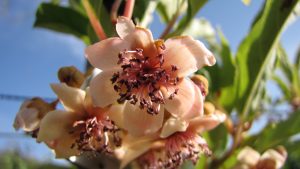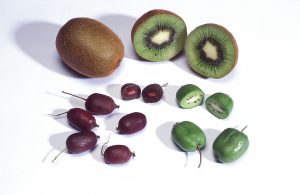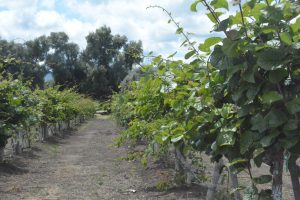Kiwifruit Collection
Alexander Sanchez, USDA-ARS National Clonal Germplasm Repository, One Shields Drive, University of California, Davis, California 95616
Gayle M. Volk, USDA-ARS National Laboratory for Genetic Resources Preservation, 1111 S. Mason St., Fort Collins, Colorado 80521
Emma Balunek, USDA-ARS National Laboratory for Genetic Resources Preservation, 1111 S. Mason St., Fort Collins, Colorado 80521
John E. Preece, USDA-ARS National Clonal Germplasm Repository, One Shields Drive, University of California, Davis, California 95616
Outline
1. Introduction
Kiwifruit, also known as “Chinese gooseberry,” is native to central and eastern China. There are approximately 50 species of kiwifruit. Out of these 50, four are commonly cultivated. The most commonly consumed kiwifruit species is Actinidia deliciosa. The other three are Actinidia chinensis (golden kiwifruit), Actinidia arguta (hardy kiwifruit), and Actinidia kolomikta (variegated kiwi vine) (Whitworth, 2017). In 1940, the first commercial kiwifruit vineyard was planted in New Zealand (Beutel, 1990). New Zealand is one of the top producers of Kiwifruit. In 2015, New Zealand produced 475,000 metric tons, or 522,495 US tons (Lee-Jones, 2016). The first plantings of kiwifruit in the United States were made in California in 1967 (Beutel 1990). In 2019, there were 4,400 acres of kiwifruit grown in the US, mostly in California. United States kiwifruit production was priced at $1,680 per ton in 2019 and production was 51,500 tons, with a total value of over $85 million (USDA NASS, 2020). While kiwifruit is a small sector of agriculture in California, the acreage of kiwifruit is increasing each year.
Kiwifruit grow on large, deciduous vines. Kiwifruit are well-known for their fuzzy skin, but some species of kiwifruit have smooth skin. Smooth skin species are more winter hardy and have smaller fruit (called kiwiberries) and leaves. Fuzzy skin kiwifruit species have large leaves and are not as cold hardy. Both male and female plants are needed for fruit production. The female plants produce fruit, but male plants must be planted nearby for fertilization (Whitworth, 2017).
Figure 1. Fruit of wild Actinidia species. Photo credit: Gayle Volk.
2. actinidia (kiwifruit) collection
The U.S. National Plant Germplasm System kiwifruit collection has 214 accessions representing twelve taxa that are maintained as trees in the field.
Figure 2. Kiwifruit (Actinidia deliciosa) (behind) are larger than hardy kiwifruit (Actinidia arguta) (front). Photo credit: USDA Image Gallery.

Figure 3. Kiwifruit blossom that is pink. Photo credit: Jenny Smith.
Figure 4. Actinidia chinensis (left) and Actinidia arguta (right) fruit on the vine. Photo credit: Gayle Volk.
Figure 5. U.S. National Plant Germplasm System kiwifruit field collection. Photo credit: Gayle Volk.
Video 1. Dr. John Preece discusses the kiwifruit collection.
3. references
Beutel JA. 1990. Kiwifruit Production in California. Small Farm Center, University of California, Davis, CA. http://sfp.ucdavis.edu/pubs/brochures/Kiwi/
Lee-Jones D. 2016. USDA Foreign Agricultural Service, Global Agricultural Information Network Kiwifruit Sector Report – 2016: New Zealand.
USDA National Agricultural Statistics Service (NASS). 2020. Noncitrus Fruits and Nuts 2019 Summary. https://quickstats.nass.usda.gov/results/93272F1D-F385-3F3E-BE6D-5DB55AEF0921
Whitworth J. 2017. Kiwifruit Production in Oklahoma. Oklahoma State University Extension. https://extension.okstate.edu/fact-sheets/kiwifruit-production-in-oklahoma.html
4. additional information
Curator: Alexander Sanchez, USDA-ARS National Clonal Germplasm Repository, One Shields Drive, University of California, Davis, CA 95616-8607, alexander.sanchez@usda.gov
5. Acknowledgments
Citation: Sanchez A, Volk GM, Balunek E, Preece JE. 2021. Kiwifruit collection. In: Volk GM, Preece JE (Ed.) Field tour of the USDA National Clonal Germplasm Repository for Tree Fruit, Nut Crops, and Grapes in Davis, California. Fort Collins, Colorado: Colorado State University. Date accessed. Available from: https://colostate.pressbooks.pub/davisrepositoryfieldtour/chapter/kiwifruit/
This training module was made possible in part by funding from USDA-ARS, Colorado State University, and the United States Agency for International Development (USAID).
Editors: Emma Balunek, Gayle Volk, Katheryn Chen
This project was funded in part by the National Academy of Sciences (NAS) and USAID, and any opinions, findings, conclusions, or recommendations expressed in such are those of the authors alone, and do not necessarily reflect the views of USAID or NAS. USDA is an equal opportunity provider and employer. Mention of trade names or commercial products in this article is solely for the purpose of providing specific information and does not imply recommendation or endorsement by the US Department of Agriculture.






